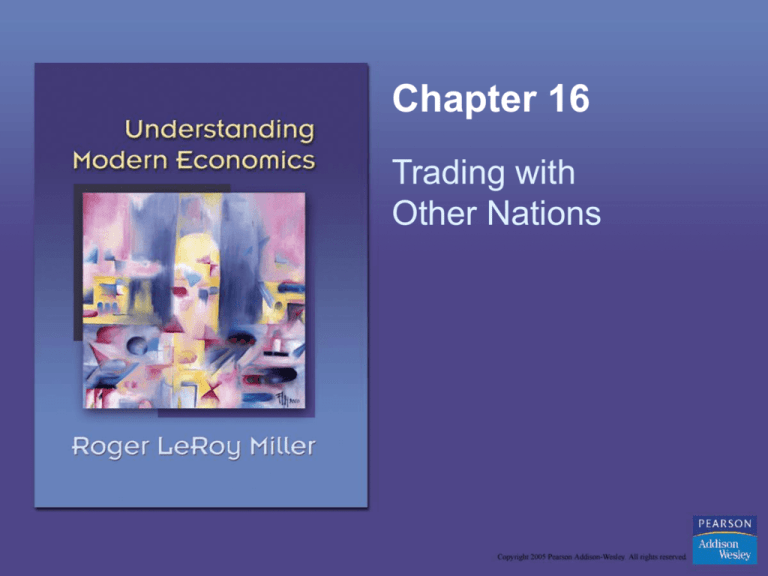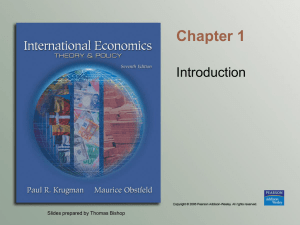
Chapter 16
Trading with
Other Nations
Learning Objectives
• Make the distinction between imports and
exports and know about the growth in world
trade.
• State why comparative advantage is more
important than absolute advantage.
• Explain the relationship between imports and
exports.
• List and describe at least three arguments
against free trade, and the two major ways of
restricting imports.
Copyright © 2005 Pearson Addison-Wesley. All rights reserved.
16-2
The Importance of World Trade
• Without any trading with other nations,
it would be more costly to buy coffee,
chocolate, or pepper in the United
States.
• Most of the consumer electronics you
purchase are made in other countries.
• Many of the raw materials used in
manufacturing in this country are also
purchased abroad.
Copyright © 2005 Pearson Addison-Wesley. All rights reserved.
16-3
Imports
• Imports are those goods and services
that we purchase from outside the
United States.
• Imports include goods we consume
directly, as well as many of the parts
that go into the manufacturing of
American-produced goods.
Copyright © 2005 Pearson Addison-Wesley. All rights reserved.
16-4
Imports (cont.)
• Today, about 14 percent of the value of
all final goods and services produced in
the United States (GDP) is made up of
imports.
• This is quite small in comparison to
other countries. In Table 16-1,next, you
see the relative importance of imports in
selected countries.
Copyright © 2005 Pearson Addison-Wesley. All rights reserved.
16-5
Table 16-1: The Importance of
Imports in Selected Countries
Copyright © 2005 Pearson Addison-Wesley. All rights reserved.
16-6
Exports
• Exports are all of the goods and
services that we sell to foreign
countries.
• Each year we export over $700 billion of
goods. In addition, we export about
$300 billion of services. These include
computer software, travel and tourism.
Copyright © 2005 Pearson Addison-Wesley. All rights reserved.
16-7
World Trade—It Just Keeps
Growing
• Back in the 1950s, imports and exports
were only about 4 percent of the U.S.
annual national income.
• Today, imports are over 14 percent, and
exports about 12 percent of GDP.
• International trade has become more
important for the United States. This is
also true for the world.
Copyright © 2005 Pearson Addison-Wesley. All rights reserved.
16-8
Why Do Nations Trade?
• International trade occurs because the
people of each nation have the ability to
produce goods and services that
residents of other nations find attractive
in terms of price, quality, and special
features.
Copyright © 2005 Pearson Addison-Wesley. All rights reserved.
16-9
Absolute Advantage
• The particular distribution of resources
of a nation often gives it an absolute
advantage over another nation in the
production of one or more goods.
• Absolute advantage is defined as the
ability to produce more output from
given inputs than other producers can.
Copyright © 2005 Pearson Addison-Wesley. All rights reserved.
16-10
Comparative Advantage
• For an individual, comparative
advantage is the ability to perform
an activity at a lower opportunity cost
than others.
• For a nation, comparative advantage
is the ability of the nation to produce
something at a lower opportunity cost
that the producers of other nations.
Copyright © 2005 Pearson Addison-Wesley. All rights reserved.
16-11
Comparing Costs of Production
• Consider a hypothetical example in
which we compare the cost of
production of digital cameras and video
game software.
• There are two countries in our example,
the United States and Japan.
Copyright © 2005 Pearson Addison-Wesley. All rights reserved.
16-12
Table 16-2: The Comparative Costs
of Production
Copyright © 2005 Pearson Addison-Wesley. All rights reserved.
16-13
Specialization
• Specialization involves working in a
relatively well-defined, limited endeavor.
• For the individual, specialization means
engaging in one particular occupation.
• For a nation, specialization means
producing a limited number of goods
and services, rather than all goods and
services that the nation’s residents
consume.
Copyright © 2005 Pearson Addison-Wesley. All rights reserved.
16-14
Specialization in Our Example
• Let’s say that there are 1,000 worker in each
country, each worker capable of producing
either digital cameras or video games
according to the numbers shown back in
Table 16-2.
• Table 16-3, next, shows daily world output
before specialization with 1000 workers in
each country, assuming that each country’s
workers are divided equally between the
production of the two goods.
Copyright © 2005 Pearson Addison-Wesley. All rights reserved.
16-15
Table 16-3: Daily World Output
Before Specialization
Copyright © 2005 Pearson Addison-Wesley. All rights reserved.
16-16
The Magic of Specialization and
Trade—Increased World Output
• In Table 16-3, world output with 1,000
workers in each country is 1,000 digital
cameras and 750 video games.
• Now assume that Japan only produces
digital cameras, leaving
to the U.S. the production of video
games.
Copyright © 2005 Pearson Addison-Wesley. All rights reserved.
16-17
The Magic of Specialization and
Trade—Increased World Output (cont.)
• Looking at Table 16-4, next, we see that the
world output of digital cameras stays the
same at 1,000. But the world output of video
games is now 1,000, instead of 750.
• There has been a gain to world production of
250 video games. These are essentially
“free” because of a more efficient allocation of
resources worldwide.
Copyright © 2005 Pearson Addison-Wesley. All rights reserved.
16-18
Table 16-4: Daily World Output After
Specialization
Copyright © 2005 Pearson Addison-Wesley. All rights reserved.
16-19
International Trade
• World output is greater when countries
specializes in producing the goods in which
they have a comparative advantage and then
engage in foreign trade.
• But not everyone is better off when free trade
occurs. In our example, U.S. digital camera
producers and Japanese video game
producers are worse off because these two
domestic industries will have disappeared
after complete specialization.
Copyright © 2005 Pearson Addison-Wesley. All rights reserved.
16-20
International Trade (cont.)
• International trade can be viewed as a
choice in each country between two
ways of acquiring a good or service—
produce it domestically or import the
product.
• If the imported good is cheaper than the
domestically produced equivalent good,
a nation can gain by importing it.
Copyright © 2005 Pearson Addison-Wesley. All rights reserved.
16-21
International Trade Leads to the
Transmission of Ideas Among Nations
• International trade also bestows
benefits on countries through the
international transmission of ideas.
• According to economic historians,
international trade has been the
principal means by which new goods,
services, and processes have spread
around the world.
Copyright © 2005 Pearson Addison-Wesley. All rights reserved.
16-22
The Relationship Between Imports
and Exports
• International trade can be looked at
as a kind of production process that
transforms exports into imports.
• What we gain as a country from
international trade is the ability to import
the things we want.
• In the long run, imports are paid for
by exports.
Copyright © 2005 Pearson Addison-Wesley. All rights reserved.
16-23
The Impact of Restrictions on
Imports
• Any restriction on imports ultimately
reduces exports.
• If we restrict the ability of the rest
of the world to sell its goods and
services to us, then the rest of the world
does not have the ability to purchase as
many goods and services as we want to
export.
Copyright © 2005 Pearson Addison-Wesley. All rights reserved.
16-24
Arguments Against Free Trade
• Protecting American jobs.
• Protecting infant industries—those that are
just getting started.
• Government subsidization of foreign
producers.
• Dumping—selling abroad at a lower price
than at home, or selling at a price that is
below the marginal cost of production.
Copyright © 2005 Pearson Addison-Wesley. All rights reserved.
16-25
Ways to Restrict Foreign Trade
• Quotas—an import quota is a restriction
imposed on the value of
or the number of units of a particular
good that can be brought into the United
States.
Copyright © 2005 Pearson Addison-Wesley. All rights reserved.
16-26
Ways to Restrict Foreign Trade
(cont.)
• Tariffs—are taxes on imports.
They can be set as a particular dollar
amount per unit, say 10 cents per
pound, or they can be set as a
percentage of the value of the imported
commodity.
Copyright © 2005 Pearson Addison-Wesley. All rights reserved.
16-27
The World Trade Organization
(WTO)
• Since 1995, the principle institution that
oversees tariffs throughout the world
has been the World Trade Organization
(WTO).
• The goal of the nations that created the
WTO was to lessen trade barriers
throughout the world so that all nations
can benefit from freer international
trade.
Copyright © 2005 Pearson Addison-Wesley. All rights reserved.
16-28
Free Trade Areas and
Common Markets
• The oldest and best-known common
market is what is known to the world
today as the European Union (EU).
• In 1993 the U.S. Congress approved
NAFTA, an agreement that created a
free trade zone that includes Canada,
the United States, and Mexico.
Copyright © 2005 Pearson Addison-Wesley. All rights reserved.
16-29
Key Terms and Concepts
• absolute advantage
• comparative advantage
• dumping
• exports
• import quota
• imports
• specialization
• tariffs
Copyright © 2005 Pearson Addison-Wesley. All rights reserved.
16-30







